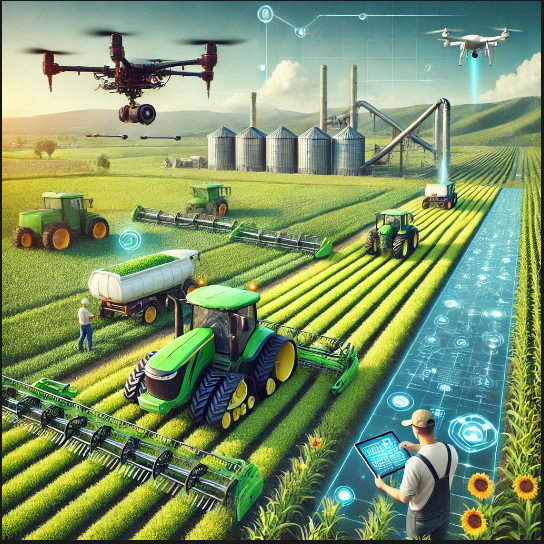Introduction
Agriculture has been the backbone of the Indian economy for centuries, providing employment to a significant portion of the population and contributing substantially to GDP. However, despite its importance, Indian agriculture faces numerous challenges, including low productivity, fragmented land holdings, and outdated farming practices. One of the most effective ways to address these issues and bridge the yield gap is through mechanized farming. Mechanization involves the use of modern tools, equipment, and machinery to improve efficiency, reduce labor dependency, and enhance agricultural output.
This essay explores the concept of mechanized farming, its significance in India, the challenges it faces, and how it can effectively bridge the yield gap to ensure food security and economic growth.
Understanding Mechanized Farming
Mechanized farming refers to the application of technology, machinery, and automation in agricultural activities. It includes the use of tractors, harvesters, irrigation systems, drones, and artificial intelligence (AI)-driven tools to optimize farming operations. By replacing traditional manual labor with machines, farmers can enhance productivity, reduce operational costs, and achieve better crop yields.
Mechanization can be categorized into different stages of farming:
- Land Preparation – Use of plows, tillers, and harrows for soil preparation.
- Sowing and Planting – Mechanized seed drills and transplanters ensure uniform planting.
- Irrigation Management – Drip and sprinkler irrigation systems improve water efficiency.
- Crop Protection – Use of pesticide sprayers, drones, and AI-driven monitoring systems.
- Harvesting and Post-Harvest Processing – Combine harvesters, threshers, and storage technology enhance efficiency.
Significance of Mechanized Farming in India
The adoption of mechanized farming has several advantages for Indian agriculture:
1. Increased Agricultural Productivity
Mechanized farming enhances the efficiency of farm operations, leading to higher crop yields. By ensuring timely plowing, sowing, and harvesting, farmers can maximize output while reducing losses due to delays.
2. Reduction in Labor Dependency
With the growing rural-to-urban migration and a shrinking agricultural workforce, mechanization provides a sustainable solution by reducing dependence on manual labor and improving overall farm efficiency.
3. Efficient Land Utilization
Mechanized tools ensure better utilization of available land, allowing farmers to cultivate larger areas efficiently. This is crucial in India, where land fragmentation often leads to inefficient farming.
4. Enhanced Water and Resource Management
Modern irrigation techniques like drip and sprinkler systems optimize water use, preventing wastage and ensuring sustainable farming practices. This is particularly important for India, where water scarcity is a major concern.
5. Post-Harvest Loss Reduction
A significant portion of agricultural produce is lost post-harvest due to improper handling, inefficient storage, and lack of processing facilities. Mechanized storage, cold chains, and food processing units can help minimize these losses and improve profitability.
6. Improved Soil Health and Environmental Sustainability
Precision farming technologies help in the judicious use of fertilizers and pesticides, reducing soil degradation and environmental pollution. Mechanization also enables conservation agriculture practices like zero tillage and crop rotation.
Challenges to Mechanized Farming in India
Despite its benefits, mechanized farming faces several obstacles in India:
1. High Cost of Machinery
Agricultural machinery is often expensive, making it unaffordable for small and marginal farmers. The high cost of mechanization hinders widespread adoption, particularly in rural areas.
2. Land Fragmentation
Most Indian farms are small and fragmented, making it difficult to use large machinery effectively. Lack of consolidated land holdings reduces the efficiency of mechanized operations.
3. Lack of Awareness and Technical Expertise
Many farmers lack awareness of modern agricultural technologies and do not possess the technical skills required to operate sophisticated machinery.
4. Inadequate Infrastructure
India’s rural infrastructure, including roads, electricity, and irrigation facilities, is often inadequate, limiting the effective use of mechanized farming equipment.
5. Limited Access to Credit and Financing
Many farmers face difficulty obtaining loans or financial assistance to invest in mechanization. The absence of tailored credit schemes and high-interest rates further discourage adoption.
6. Environmental Concerns
While mechanization improves efficiency, excessive use of heavy machinery can lead to soil compaction and degradation if not managed properly.
Strategies to Promote Mechanized Farming in India
To bridge the yield gap effectively, the following strategies should be adopted:
1. Subsidies and Financial Support
Government initiatives should provide subsidies and low-interest loans to encourage farmers to invest in mechanization. Schemes like the Sub-Mission on Agricultural Mechanization (SMAM) should be expanded and made more accessible.
2. Custom Hiring Centers (CHCs)
Establishing CHCs that allow farmers to rent high-cost agricultural machinery on a need basis can make mechanization affordable and accessible to small farmers.
3. Cooperative Farming and Land Consolidation
Encouraging cooperative farming can help consolidate land holdings, making mechanized farming more viable and efficient.
4. Skill Development and Training
Organizing training programs and workshops on modern agricultural techniques can equip farmers with the necessary skills to operate machinery efficiently.
5. Investment in Rural Infrastructure
Developing rural roads, irrigation facilities, and electricity supply can create a supportive environment for mechanized farming.
6. Research and Development (R&D)
Encouraging R&D in indigenous, cost-effective, and region-specific farm machinery can make mechanization more suitable for Indian conditions.
Future Prospects of Mechanized Farming in India
The future of mechanized farming in India looks promising with ongoing advancements in agri-tech and government initiatives. The integration of smart farming technologies like AI, machine learning, and the Internet of Things (IoT) is expected to revolutionize Indian agriculture.
Key future trends include:
- Precision Agriculture – Using satellite imagery and AI to optimize farming inputs.
- Drones for Crop Monitoring – Enhancing real-time field assessment.
- Robotics and Automation – Introducing autonomous tractors and robotic harvesters.
- Digital Platforms and IoT – Connecting farmers with real-time data for better decision-making.
- Sustainable Mechanization – Promoting eco-friendly and low-emission machinery.
Conclusion
Mechanized farming holds immense potential to bridge the yield gap in India, ensuring higher agricultural productivity, improved resource management, and better economic returns for farmers. While challenges exist, a combination of policy support, financial incentives, and technological advancements can accelerate the adoption of mechanized farming across the country. By embracing modern agricultural practices, India can move towards a more sustainable and efficient farming future, ensuring food security and prosperity for millions of farmers.




